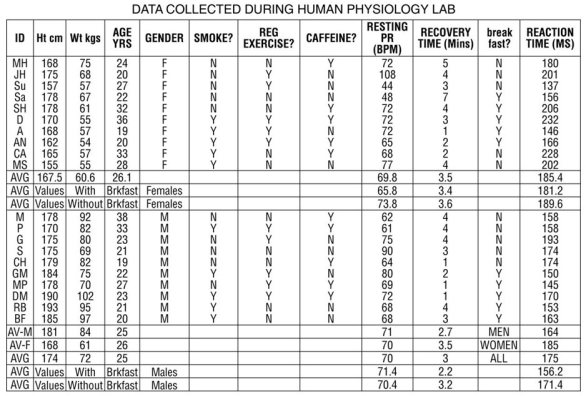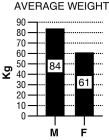Following is a table of data collected from one section of an 8 a.m.physiology lab.There were 20 students present,10 men and 10 women.Information collected from the students included their height,weight,age,and resting pulse rate.In addition,the students were surveyed to see if they smoked cigarettes,considered themselves "regular exercisers," if they had consumed caffeine the morning of the lab,and if they had eaten breakfast that day.A "y" or "n" (yes or no)was recorded to indicate their answers.Each student did "jumping jacks" for 5 minutes and recorded the time required to regain their resting heart rate,which is listed on the table as "recovery time." Finally,each student participated in an exercise designed to measure their reaction time (in milliseconds)in catching an object dropped by a lab partner according to specified criteria.Use this table to answer the following questions.Ignore statistical problems caused by small sample size,and so on.  Table 1.3
Table 1.3  For these questions,the data were separated and analyzed by gender.
For these questions,the data were separated and analyzed by gender.
-Refer to Table 1.3 and the bar graph.
A.Disregarding gender,write a hypothesis that expresses the relationship between weight and height.
B.What is the dependent variable? What is the independent variable?
C.From the data in Table
1.3,construct a graph that examines this relationship.
Definitions:
Unrealized Loss
A decrease in the value of an investment or asset that has not been sold, hence the loss has not been realized.
Fair Value Adjustment
A correction made to the reported value of an asset or liability to align it with its market value.
Discounted Note
A debt instrument that is sold or issued for less than its face value and whose return comes from the difference between the purchase price and the face value paid at maturity.
Proceeds
The amount of money received from a transaction, often used in the context of sales or the disposition of assets.
Q2: Management's responsibility in a computer system would
Q7: their loss is characteristic of cancer<br>A)gap junction<br>B)tight
Q37: The term meaning programmed cell death is<br>A)
Q40: Each of the following is a type
Q41: chondrocyte<br>A)cartilage<br>B)destroys bone matrix<br>C)loose connective tissue<br>D)fat<br>E)maintains bone matrix
Q44: This year,Blakeney Enterprises engaged a new auditor
Q65: A certain reaction pathway consists of four
Q72: PCAOB inspections are conducted by<br>A) individuals selected
Q84: Increasing _ will decrease the amount of
Q139: Define the law of mass action.